If you’re looking for the top 13 modular electronic test systems of 2025, I’ve got you covered. These include everything from quick-use diagnostic kits to advanced microcontroller debuggers and versatile breadboards. Whether you’re troubleshooting wiring, testing circuits, or prototyping, these systems offer precision and flexibility for any project. Stay tuned, as you’ll find detailed insights into each device to help you choose the best tools for your needs.
Key Takeaways
- The list highlights versatile modular test systems including diagnostic kits, wiring tools, microcontroller debuggers, and prototyping platforms.
- Emphasis on systems offering high precision, expandability, and compatibility with various communication protocols.
- Includes solutions suitable for both DIY enthusiasts and professional engineers, covering basic to advanced testing needs.
- Features modular designs like the STLINK-V3SET debugger and SparkFun MicroMod ecosystem for flexible customization.
- Focuses on systems with rapid setup, reliable performance, and adaptability for evolving electronic testing requirements in 2025.
Epstein Barr (EBV) Test Kit for Home Use
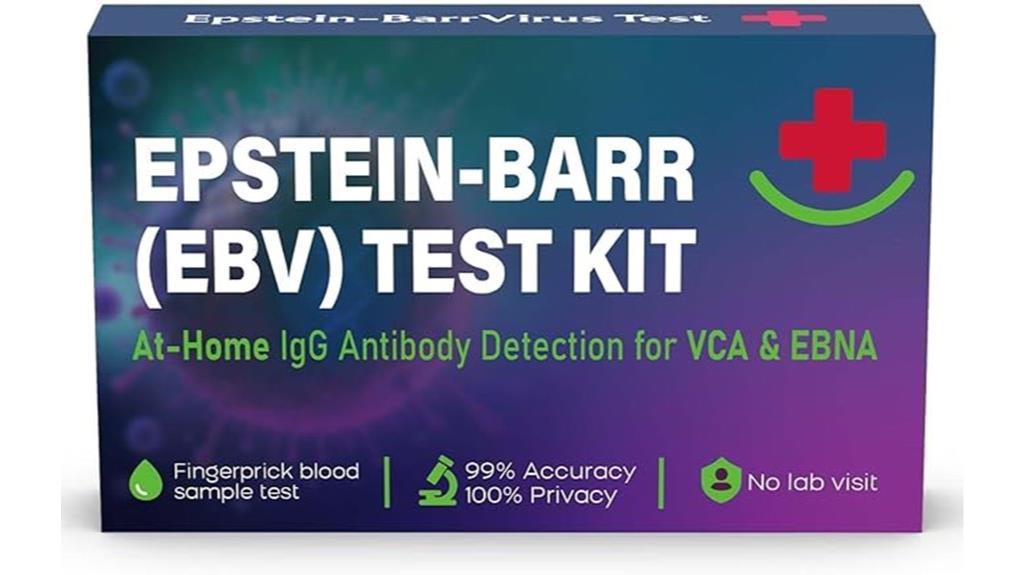
If you’re looking for a quick and reliable way to check your EBV exposure at home, the Epstein Barr (EBV) Test Kit is an excellent choice. This kit detects VCA and EBNA IgG antibodies, giving you insight into your immune response within about 15 minutes. It’s simple to use, with all components included—lancet, cassette, buffer, and instructions—so you don’t need a lab visit. Just follow the easy steps, collect a fingerstick blood sample, and read the results. Designed for privacy and convenience, this kit offers dependable, fast results, making it ideal for anyone monitoring their health or curious about past EBV exposure.
Best For: individuals seeking a quick, private, and reliable home test to determine past or current EBV exposure without visiting a lab.
Pros:
- Easy to use with all components included, suitable for at-home testing.
- Provides rapid results within approximately 15 minutes.
- Discreet and portable packaging ensures privacy and convenience.
Cons:
- May require proper interpretation of results, which could be challenging for some users.
- Not a substitute for comprehensive lab testing or medical advice.
- Limited to detecting VCA and EBNA IgG antibodies; does not provide detailed health insights.
Klein Tools Beginner Tester Kit (80097)

The Klein Tools Beginner Tester Kit (80097) stands out as an ideal choice for homeowners and DIY enthusiasts seeking reliable electrical testing tools. This 3-piece set includes a Non-Contact Voltage Tester, Receptacle Tester, and GFCI Tester, covering most household troubleshooting needs. It offers quick detection of live wires with visual and audible alerts, making safety straightforward. The kit’s compact, lightweight design and easy-to-use features suit both beginners and experienced users. Rated highly for build quality and effectiveness, it’s perfect for verifying power, diagnosing wiring problems, and ensuring safety during household electrical projects. Overall, this kit provides an excellent balance of reliability and convenience.
Best For: homeowners and DIY enthusiasts seeking reliable, easy-to-use electrical testing tools for household troubleshooting and safety verification.
Pros:
- Compact, lightweight design makes it portable and easy to handle.
- Includes three versatile testers for comprehensive electrical diagnostics.
- High customer ratings (4.6/5) reflect strong build quality and effectiveness.
Cons:
- Bright sunlight can make the LED indicators appear dim.
- Some users find the leads could be longer for easier testing.
- Limited to residential use, not suitable for industrial or professional electrical work.
Klein Tools ET60 Voltage Tester
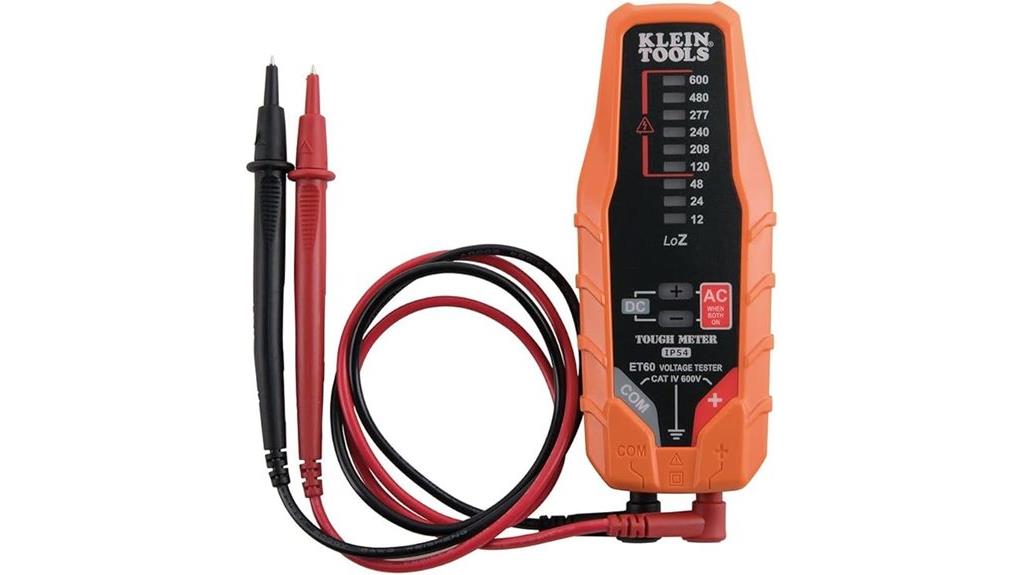
When testing AC/DC voltage up to 600V, the Klein Tools ET60 Voltage Tester stands out as an ideal choice for electricians and electrical technicians seeking safety, reliability, and versatility in one device. It tests nine voltage levels from 12-600V, compatible with standard multimeter leads for flexible use. Its CAT IV 600V safety rating and solid-state design guarantee maximum protection. The bright LED display provides quick, accurate readings, while the low input impedance prevents false ghost voltages. Powered directly by the circuit, it eliminates the need for batteries. Built-in test lead holders add convenience, making it a dependable, user-friendly tool for various electrical testing applications.
Best For: electricians and electrical technicians needing a reliable, safe, and versatile voltage tester for residential, commercial, and industrial electrical work.
Pros:
- Wide testing range of 12-600V AC/DC, suitable for most common electrical applications
- CAT IV 600V safety rating ensures maximum protection during testing
- Battery-free operation powered directly by the circuit for continuous, uninterrupted use
Cons:
- Limited to voltage testing; does not measure current or resistance
- Requires compatible multimeter test leads, which may need to be purchased separately
- No advanced features like data logging or connectivity options
LCR-T4 Digital Transistor Tester with Case
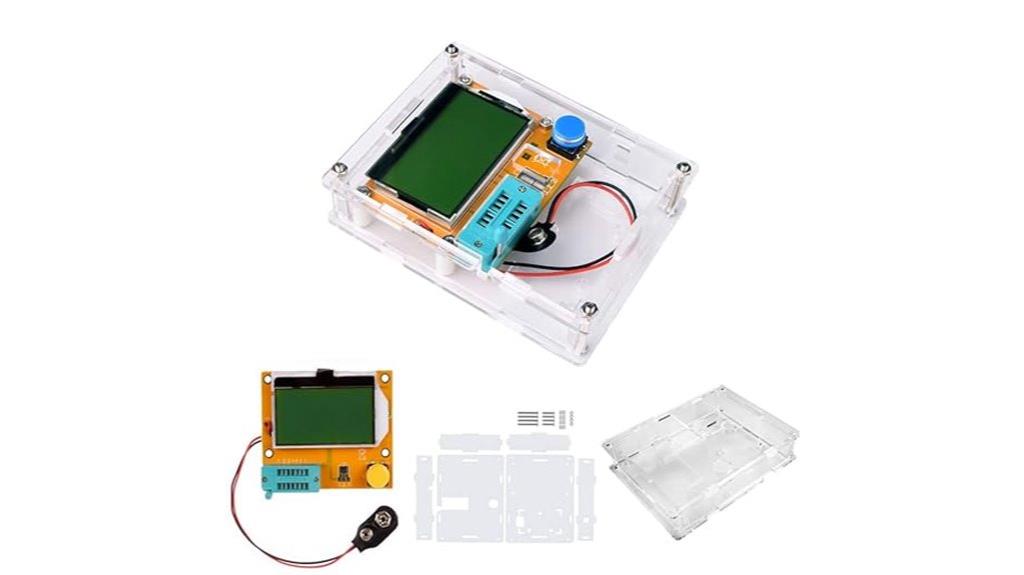
The LCR-T4 Digital Transistor Tester with Case stands out as an excellent choice for hobbyists, students, and technicians who need a versatile and affordable testing device. It measures resistance, capacitance, inductance, diodes, transistors, MOSFETs, SCRs, and voltage regulators with high accuracy. The device quickly identifies component types, pinouts, polarities, and values, displaying detailed schematic symbols on a backlit LCD. Its auto power-off conserves battery life, and calibration is straightforward. Although assembly can be tricky, the sturdy case guarantees durability. Overall, it offers impressive performance for around $13, making it a valuable, cost-effective tool for repair, design, and learning.
Best For: hobbyists, students, and technicians seeking an affordable, versatile, and reliable component tester for repair, design, and educational purposes.
Pros:
- Measures a wide range of components including resistors, capacitors, inductors, diodes, transistors, and more with high accuracy.
- Fast testing speed typically around 2 seconds per component, with detailed schematic and polarity info displayed on a backlit LCD.
- Excellent value at approximately $13, with good build quality and responsive customer support.
Cons:
- Assembly can be somewhat tricky and the case may be finicky to put together.
- Battery replacement requires disassembly, and some units arrive DOA or with minor defects.
- Slow test times for larger capacitors and occasional durability issues reported by users.
TEMPO 711K Digital Tone Generator and Probe Kit

If you’re working with complex wiring systems or troubleshooting multiple lines, the TEMPO 711K Digital Tone Generator and Probe Kit delivers exceptional performance with its three selectable tone outputs, making it ideal for professionals who need precise and efficient wire identification in intricate network environments. Built with USA quality control standards, it features noise-immune toner and microprocessor-controlled circuitry for accurate signal modulation. The kit includes versatile probe options with metallic or plastic tips and a detachable 2-line test lead. Its powerful speaker and LED signal indicators ensure reliable detection, even in noisy settings, providing a thorough solution for complex cable testing and troubleshooting.
Best For: professionals working with complex wiring systems and multiple cable lines who require precise, noise-immune wire identification and testing.
Pros:
- Equipped with three selectable tone outputs for diagnosing multiple lines simultaneously
- Noise-immune toner and powerful speaker for accurate detection in noisy environments
- Versatile probe options with metallic or plastic tips and a detachable test lead for adaptability
Cons:
- May be more complex to operate for beginners unfamiliar with advanced cable testing tools
- Slightly bulkier design due to multiple features and components
- Requires batteries, which need regular replacement or recharging for continued use
STLINK-V3SET Hardware Debugger and Programmer for STM32/STM8

Designed for developers working with STM32 and STM8 microcontrollers, the STLINK-V3SET stands out with its modular, stand-alone design that supports multiple debugging interfaces like SWD, JTAG, and SWIM. It includes a main module and adapter board, enabling in-circuit and in-system debugging, firmware updates, and programming. Supporting high-speed USB 2.0 and a Virtual COM port, it offers flexible communication options, including SPI, I2C, CAN, and GPIOs. Its compatibility with ARM Cortex M cores and STM8/STM32 series makes it versatile. The device’s extendable architecture and straightforward setup make it an essential tool for precise, reliable debugging and programming in modern development workflows.
Best For: embedded systems developers and engineers working with STM32 and STM8 microcontrollers who need versatile, reliable debugging and programming tools.
Pros:
- Supports multiple debugging interfaces (SWD, JTAG, SWIM) for flexible target connectivity
- Modular, extendable design enabling customization and additional communication options
- High-speed USB 2.0 interface with Virtual COM port for seamless firmware updates and communication
Cons:
- Does not include a microUSB cable, requiring users to purchase one separately
- Slightly larger and heavier compared to some other debugging tools, which may impact portability
- Firmware updates and feature activation may require technical familiarity with device management
Cable Finder Circuit Tester and Tone Generator Kit

For DIY enthusiasts and homeowners tackling basic wiring tasks, the Cable Finder Circuit Tester and Tone Generator Kit offers a practical solution. It helps locate cables, verify wire continuity, and identify specific wires among multiple lines, making it ideal for home wiring, intercoms, and automotive projects. The multifunctional design includes modes for continuity testing and wire identification, with an RJ11 connector for phone systems. While it’s budget-friendly and easy to use for small tasks, some users find its build quality lacking and its detection range limited. It’s a handy tool for DIYers but not recommended for critical or professional wiring work.
Best For: DIY homeowners and hobbyists needing an affordable tool for basic cable location, continuity testing, and wire identification in low-voltage applications.
Pros:
- Easy to use and suitable for small DIY projects like home wiring and cable repairs
- Compact and lightweight design for convenient handling and storage
- Includes multifunction modes for continuity testing and wire identification
Cons:
- Build quality is often poor, with some units feeling cheaply made and lacking durability
- Limited detection range and effectiveness mainly in low-noise environments; not suitable for live power or complex wiring systems
- Battery replacement can be difficult due to design flaws, and the device may lack indicator lights for power or testing status
SparkFun MicroMod ATP Carrier Board, Modular Interface Ecosystem
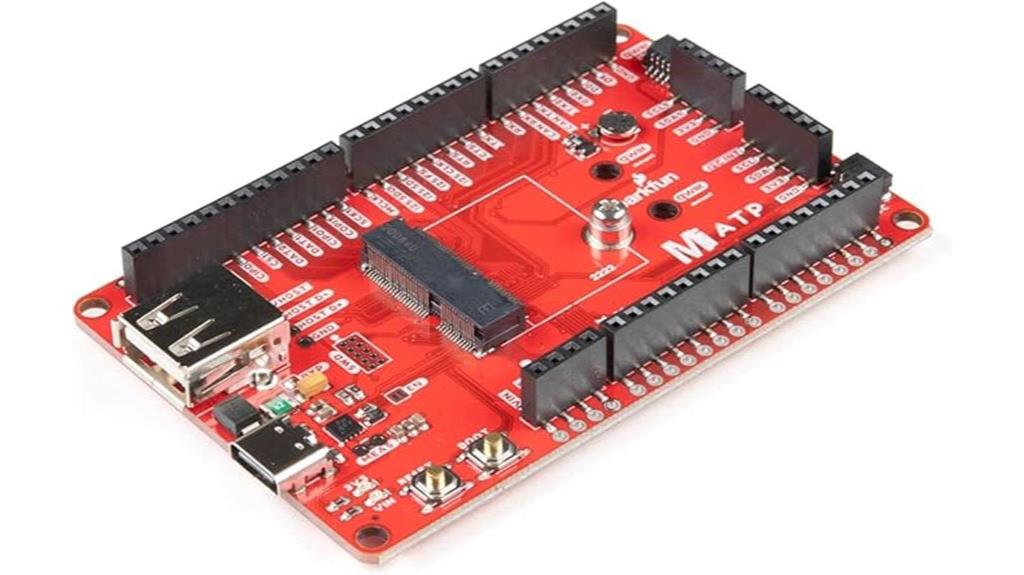
The SparkFun MicroMod ATP Carrier Board stands out as an ideal choice for developers seeking a flexible, modular interface ecosystem. It connects MicroMod Processor Boards to peripherals, offering access to all pins via an M.2 connector, broken out to headers and PTH pads. Compatible with the MicroMod ecosystem, it needs a processor board for full functionality. Power options include VIN with a regulated 3.3V output and a backup RTC battery. Multiple ports—USB Type-C, Type-A, I2C, CAN, SPI, UARTs—support diverse peripherals. Its design includes buttons, LEDs, and headers, making it versatile for various testing and development applications.
Best For: hobbyists and developers seeking a versatile, modular interface ecosystem to connect microcontroller processor boards with a variety of peripherals for testing and development.
Pros:
- Offers comprehensive access to all processor pins via M.2 connector, headers, and PTH pads for flexible prototyping.
- Supports a wide range of connectivity options including USB, I2C, CAN, SPI, UARTs, and analog inputs.
- Includes onboard power regulation and backup RTC battery, enhancing stability and timekeeping during projects.
Cons:
- Requires a compatible MicroMod processor board for full operation, adding to overall system complexity.
- Not all pins may be accessible depending on the specific processor board used, potentially limiting certain connections.
- As a carrier board only, it does not include processing capabilities itself, necessitating additional components for standalone use.
BB400 Solderless Plug-in BreadBoard
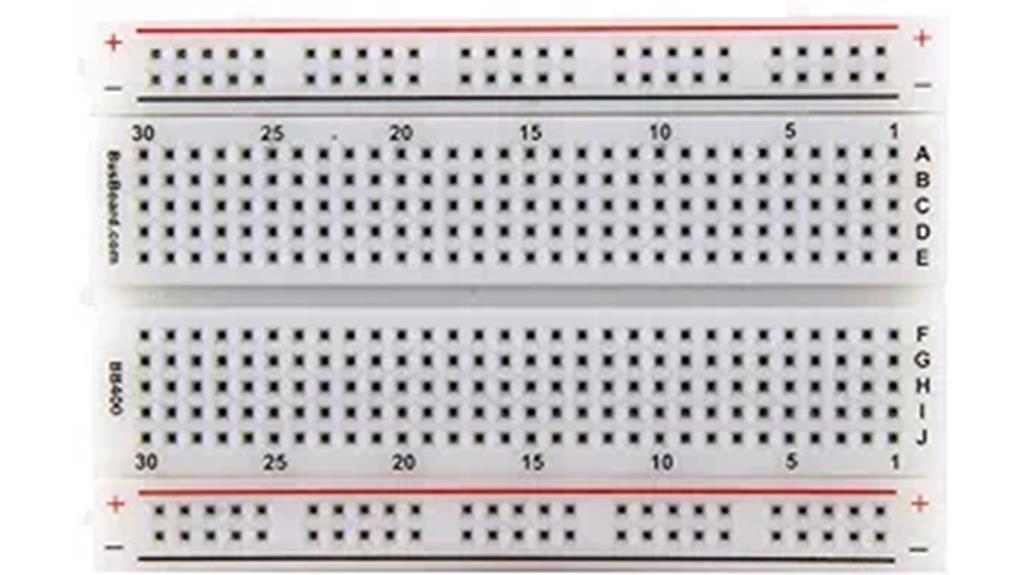
The BB400 Solderless Plug-in BreadBoard stands out with its compact size and 400 tie points, making it an ideal choice for quick prototyping and electronics experimentation. Its design includes 300 tie points in the IC-circuit area and two 50-point distribution strips with color-coded power rails, all within dimensions of just 3.3 x 2.2 x 0.3 inches. Made from durable white ABS plastic with clear legends, it supports wires from 21 to 26 AWG and can handle voltages up to 36V and currents of 2A. The included peelable adhesive backing guarantees stable placement, making it a versatile and reliable prototyping tool.
Best For: electronics hobbyists, students, and professionals seeking an affordable, compact, and reliable breadboard for quick prototyping and circuit testing.
Pros:
- Compact size with 400 tie points for versatile circuit assembly
- Durable construction with high-quality phosphor bronze contacts rated for 50,000 insertions
- Color-coded power rails and clear legends for easy identification and wiring
Cons:
- Limited to wires ranging from 21 to 26 AWG, restricting some larger gauge connections
- Smaller footprint may not accommodate extensive or complex circuits
- Absence of additional features like built-in power supplies or multiple power options
Evaluation Kit for Control System with Smart Servo Stepper, Driver & Motion Controller

If you’re seeking a versatile testing solution that simplifies integrating advanced control systems, the Evaluation Kit for Control System with Smart Servo Stepper, Driver, and Motion Controller stands out. It features a fully functional control setup, including smart servo steppers with encoders, a control gateway, power supply, and I/O board—all in a compact, plug-and-play package. Designed for quick deployment, it supports modular automation and precise motor control across various environments like labs, factories, and hospitals. With free software, robust hardware, and excellent customer support, this kit offers reliability and flexibility, making complex control system development faster and easier.
Best For: engineers and developers seeking a reliable, modular control system for automation, robotics, and industrial applications requiring precise motor control.
Pros:
- Plug-and-play, easy-to-install design reduces setup time.
- Supports a wide range of environments including labs, factories, and hospitals.
- Comes with comprehensive software, SDK, and customer support for seamless integration.
Cons:
- Premium pricing may be a barrier for small-scale projects.
- Limited details on specific motor specifications and customization options.
- Does not include batteries, requiring external power sources for operation.
Fluke TS19 Test Set for Circuit Testing
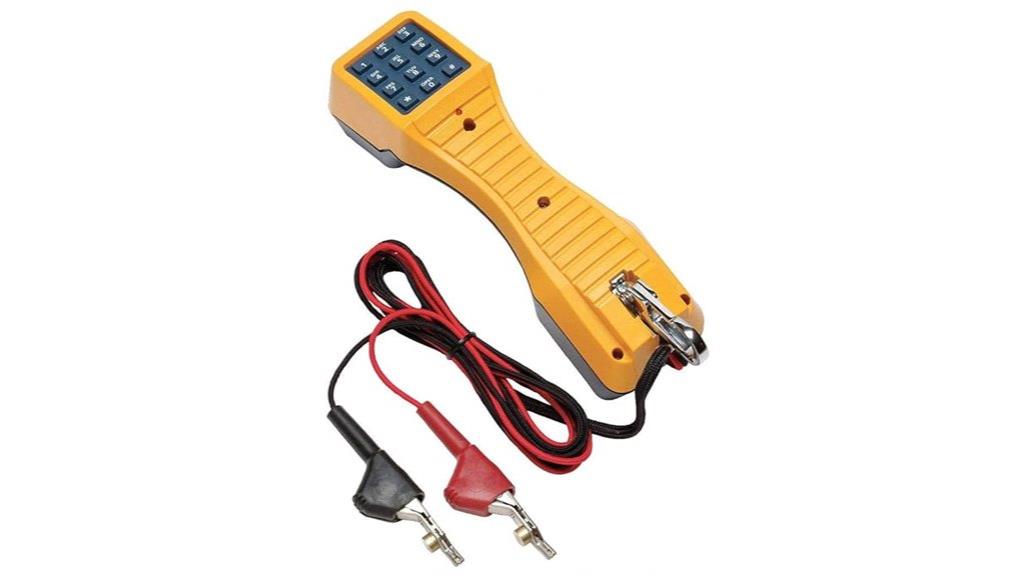
Designed specifically for network technicians, the Fluke TS19 Test Set offers reliable performance and user-friendly features that make circuit testing straightforward. Its simple design suits in-house technicians, with tone/pulse compatibility and last number redial for quick, efficient testing. The high impedance monitor prevents circuit disturbance, ensuring accurate results without affecting digital or data circuits. Talk monitor capabilities allow hands-free operation, enhancing safety and convenience. The replaceable spring-loaded belt clip makes it easy to carry. Overall, the TS19 combines durability with essential testing features, making it a dependable tool for precise circuit analysis in demanding network environments.
Best For: in-house network technicians needing a reliable, easy-to-use circuit testing tool that won’t disrupt data or digital circuits.
Pros:
- User-friendly with simple performance suitable for in-house use
- High impedance monitor prevents circuit disturbance during testing
- Features like tone/pulse compatibility and last number redial enhance efficiency
Cons:
- Limited advanced testing capabilities for complex network issues
- May lack features required for professional field technicians
- Physical design may not be suitable for rugged outdoor environments
Prototype Breadboard Clear Crystal SYB 120 400 500 830 840 1660 MB102 Solderless Modular Board (2pc)

For electronics enthusiasts and professionals seeking a reliable, versatile prototyping platform, the Prototype Breadboard Clear Crystal SYB 120 and its variants stand out. These solderless, modular breadboards feature transparent crystal plastic, making it easy to see connections. Available in sizes like 400 and 830 tie points, they support a wide range of components and jumper wires. Designed for experimentation and DIY projects, they’re lightweight and easy to set up. The 2-piece sets allow flexible configurations, making them ideal for desktop or portable use. With a solid build and proven customer satisfaction, these breadboards are a smart choice for precise prototyping.
Best For: hobbyists, students, and professionals seeking a reliable, transparent, and versatile prototyping platform for electronics projects.
Pros:
- Clear crystal design for easy visual inspection of connections.
- Compatible with a wide range of jumper wires and electronic components.
- Modular and lightweight, suitable for both desktop and portable use.
Cons:
- Limited to the sizes available (e.g., 400 and 830 tie points), which may not suit all projects.
- Plastic material, while durable, may be less robust under heavy or frequent use.
- Slightly higher cost compared to basic non-transparent breadboards of similar size.
ASI IMACPGFI02 DIN Rail GFCI Outlet Interface Module
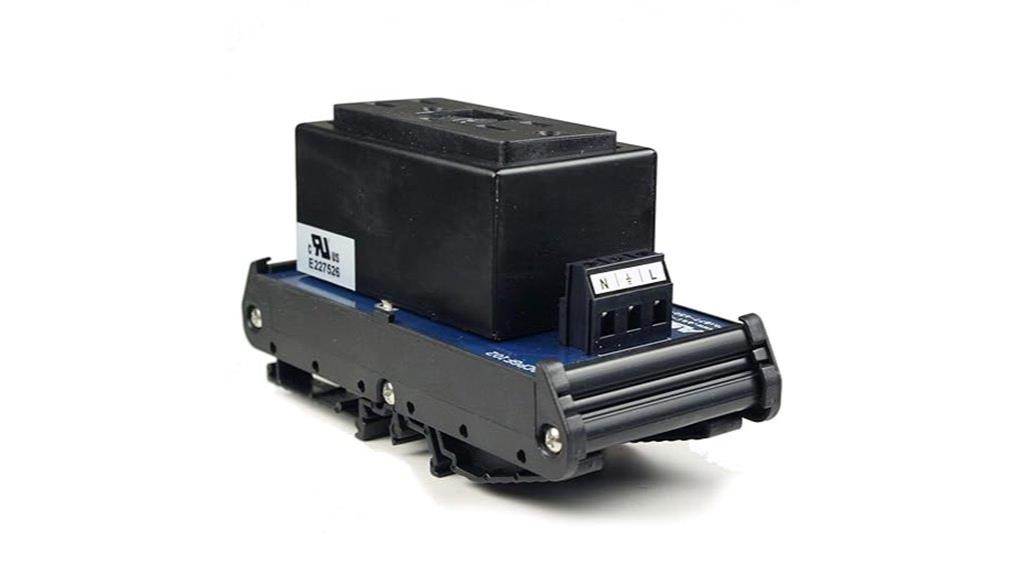
The ASI IMACPGFI02 DIN Rail GFCI Outlet Interface Module stands out for its compact design and easy installation, making it an excellent choice for control panels where space is limited. It features two GFI AC receptacles with simple reset buttons, an LED indicator, and metal-reinforced sockets for durability. The one-piece design simplifies inventory and reduces installation time, snapping onto standard DIN rails in 5-inch deep enclosures. Supporting 15 Amp, 120 Vac power and surge protection, it ensures safety and reliability. Wiring is straightforward with modular screw clamp connections, making it ideal for applications needing accessible GFCI outlets without sacrificing space or stability.
Best For: control panel installations requiring space-efficient, reliable GFCI outlets with easy wiring and maintenance.
Pros:
- Compact, space-saving design suitable for 5-inch deep enclosures
- Easy installation with simple screw clamp wiring and one-piece construction
- Durable metal-reinforced sockets and surge protection enhance safety and longevity
Cons:
- Limited clearance may make plugging in flexible cables more difficult
- Does not support connecting multiple outlets through a second terminal strip
- Suitable primarily for standard applications; less ideal for devices with tough or non-flexible cables
Factors to Consider When Choosing Modular Electronic Test Systems
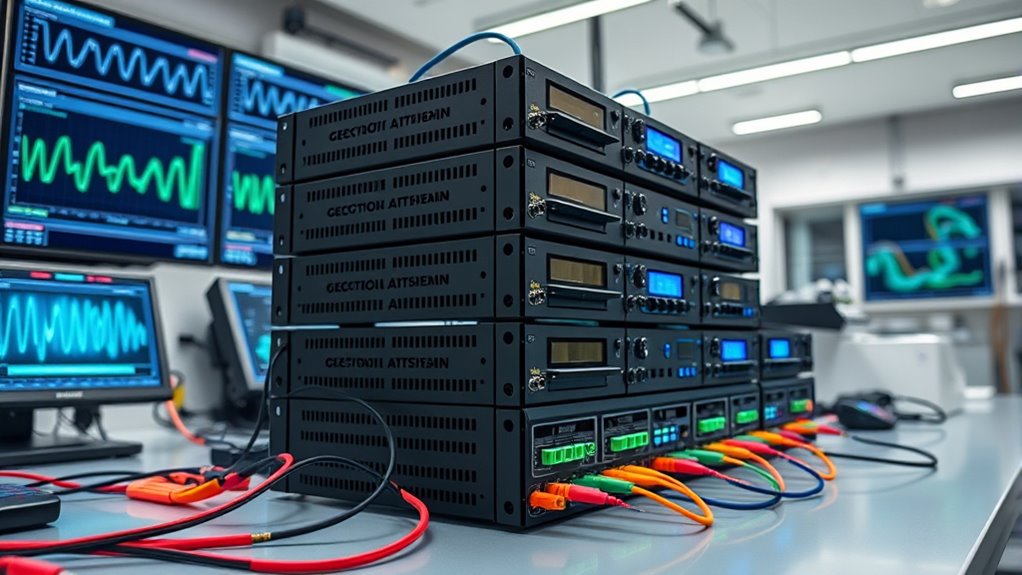
When selecting a modular electronic test system, I focus on compatibility with my devices to guarantee seamless integration. I also consider measurement accuracy standards to ensure reliable results and look for systems that are easy to operate. Additionally, portability, size, and power supply options play a vital role in fitting the system into my workflow efficiently.
Compatibility With Devices
Choosing a modular electronic test system requires careful attention to device compatibility to guarantee smooth operation. First, I verify the system supports the communication protocols and interfaces my devices need, like JTAG, SWD, UART, or I2C. Compatibility also means verifying voltage and current levels to avoid damaging components or getting inaccurate results. I check that the test modules and accessories match the form factors and connection types, including pin spacing and connectors. Additionally, I confirm the system’s software and firmware are compatible with my device’s versions, supporting essential debugging and programming features. Finally, I consider whether the system integrates seamlessly with my existing hardware and software environment, helping me streamline workflows and prevent troubleshooting headaches. Compatibility is key to maximizing the system’s efficiency and reliability.
Measurement Accuracy Standards
Measurement accuracy standards are crucial because they determine how reliable and precise the data a test system provides truly is. When evaluating modular electronic test systems, I focus on how well they meet industry standards like ISO/IEC 17025 or ANSI/NCSL Z540.1, which confirm trusted calibration and accuracy. Calibration procedures and traceability to national standards are essential for maintaining performance over time. I also consider factors such as temperature stability, noise immunity, and component tolerances, as these can impact measurement precision. Regular verification and calibration are necessary to detect drift and ensure ongoing accuracy. Ultimately, choosing a system with clear accuracy specifications, compliance certifications, and robust calibration protocols guarantees the trustworthy data needed for high-stakes testing environments.
Ease of Operation
Ease of operation is a critical factor that can considerably influence your efficiency and confidence when working with modular electronic test systems. Intuitive interfaces with clear displays and straightforward controls make setup and adjustments quick and simple. Features like thorough step-by-step instructions or automatic calibration routines help you operate the system effectively without needing specialized training. Lightweight, ergonomic designs with portable form factors and accessible connection points reduce fatigue and make handling easier. Systems that include automated testing functions and preset configurations minimize manual setup, lowering the chance of errors. User-friendly software with guided workflows and visual indicators enhances operational efficiency and shortens the learning curve. Choosing a system with these features ensures smoother operation and faster results.
Portability and Size
Portability and size are key considerations when selecting a modular electronic test system, especially if you frequently work on-site or need to move between different locations. A compact, lightweight design makes transport easier and setup faster, saving valuable time in the field. Features like integrated handles, carrying cases, or modular components that can be quickly assembled and disassembled add to convenience. Smaller form factors allow me to carry multiple testing modules in a single bag, boosting efficiency during mobile operations. However, I also consider durability and functionality to ensure the system withstands rugged environments without sacrificing performance. Striking the right balance between size, weight, and robustness is essential for seamless portability and effective testing in diverse environments.
Power Supply Options
Choosing the right power supply options is essential when selecting a modular electronic test system because it directly impacts the system’s versatility and reliability across different testing environments. I look for systems that offer multiple power sources like USB, batteries, external adapters, and DC inputs, so I can adapt to various scenarios. Ensuring the power supply matches the system’s voltage and current needs is critical for safe, stable operation. Some systems include built-in rechargeable batteries, perfect for portability, while others rely on external power for continuous testing. I also consider power stability and noise filtering, which are vital for accurate measurements. Features like auto power-off and low-battery indicators further boost system longevity and user convenience, making the testing process more efficient.
Durability and Build Quality
When selecting a modular electronic test system, durability and build quality are essential for guaranteeing reliable performance over time. I look for systems made from high-quality materials like reinforced plastics, corrosion-resistant contacts, and sturdy connectors, which can handle repeated use and tough environments. The rated number of insertion cycles is a good indicator of build quality; premium systems often support tens of thousands of connections without failure. Robust enclosures with secure locks protect internal components from dust, moisture, and shocks, extending their lifespan. Well-designed systems also include strain relief and secure wiring terminals to prevent connection issues caused by cable stress or vibration. Ultimately, adherence to manufacturing standards and safety certifications ensures the system remains reliable under operational stresses over the years.
Cost and Budget Range
The price range for modular electronic test systems varies widely, from budget-friendly options around $50 to professional-grade setups exceeding $1,000. Setting a clear budget helps you focus on essential features and avoid overspending on unnecessary capabilities. Keep in mind that costs aren’t just about the initial purchase—additional expenses for accessories, calibration, and future upgrades can add up. Cheaper systems might lack advanced functionalities like multi-parameter testing or data logging, which can impact long-term value. Investing a bit more in a reliable, higher-quality system often reduces maintenance costs and enhances accuracy, making it more cost-effective over time. Balancing your needs with your budget ensures you select a system that offers both performance and flexibility without exceeding your financial limits.
Frequently Asked Questions
How Do Modular Test Systems Integrate With Industry 4.0 Automation?
Modular test systems seamlessly integrate with Industry 4.0 automation by connecting through IoT platforms, enabling real-time data exchange and remote control. I see them as adaptable, allowing easy upgrades and customization to meet evolving needs. They communicate with other automated equipment via standardized protocols, enhancing efficiency and accuracy. This integration helps me optimize testing processes, reduce downtime, and guarantee quality across the entire manufacturing ecosystem.
What Cybersecurity Measures Protect Sensitive Test Data in Modular Systems?
I prioritize cybersecurity by implementing robust encryption for all data at rest and in transit, ensuring only authorized personnel access sensitive test data. I also use multi-factor authentication and regular security audits to spot vulnerabilities early. Additionally, I keep firmware and software updated to patch potential security flaws. These measures help protect my modular test systems from cyber threats, safeguarding valuable information and maintaining system integrity.
Can Modular Test Systems Be Customized for Non-Standard Voltage Ranges?
Absolutely, modular test systems can be customized for non-standard voltage ranges. Think of them as a tailored suit—adjustable to fit unique needs rather than a one-size-fits-all. I’ve seen engineers easily modify modules or integrate specialized components to handle unusual voltages, ensuring precise testing without sacrificing flexibility. This adaptability makes modular systems ideal for diverse applications, giving you the confidence to test even the most unconventional voltage requirements effectively.
How Do Maintenance Requirements Vary Between Different Modular Test Architectures?
Maintenance needs vary considerably across modular test architectures. I find that traditional systems often require more frequent calibration and part replacements, while newer, digital architectures tend to have self-diagnostic features that simplify upkeep. Modular systems with easily accessible components make maintenance quicker and less disruptive. Overall, choosing an architecture aligned with your operational needs can reduce downtime and ensure consistent performance, saving both time and costs in the long run.
What Are the Environmental Durability Standards for Modular Electronic Test Systems?
Environmental durability standards for modular electronic test systems typically include compliance with IP ratings, ensuring resistance to dust and water, and MIL-STD specifications for shock and vibration. I always look for systems that meet or exceed these standards because they guarantee reliability in harsh conditions. Additionally, certifications like IEC 60068 help guarantee the system’s robustness against temperature extremes, humidity, and other environmental factors, which is vital for long-term performance.
Conclusion
Choosing the right modular electronic test system is like selecting the perfect key for a complex lock—each piece must fit just right. Whether you’re testing circuits or diagnosing issues, these tools are your trusted keys to unlatch precision and flexibility. As you explore your options, remember that the right system not only solves problems but also opens new doors to innovation. Trust in these systems to be the key to your success.









